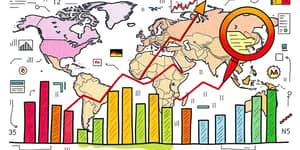
Inflation touches every corner of our lives, from the cost of groceries to rent payments. By understanding the Consumer Price Index, or CPI, we gain a window into the heartbeat of an economy. This article will guide you through the CPI’s definition, calculation process, real-world applications, and limitations. Armed with this knowledge, you can make more informed financial decisions and appreciate the broader forces shaping prices.
The Consumer Price Index is a vital gauge that measures monthly changes in prices paid by consumers for a carefully chosen basket of goods and services. Developed and maintained by statistical agencies like the U.S. Bureau of Labor Statistics, the CPI serves as the primary benchmark for inflation and deflation.
Beyond academic interest, the CPI plays a key role in policy making. Central banks target CPI figures when setting interest rates, while governments adjust social benefits and tax brackets based on CPI movements. For everyday households, tracking the CPI helps with budgeting, long-term planning, and understanding purchasing power.
Accurate CPI calculation begins with robust data collection. Each month, statistical agencies gather around 80,000 price quotes from retail stores, service establishments, rental units, and medical offices across urban areas. This effort ensures coverage of approximately 93% of the population.
To reflect real spending, the CPI relies on a market basket built from detailed consumer expenditure surveys. Over 20,000 households participate in quarterly interviews, while another 12,000 maintain weekly diaries for frequently purchased items. These surveys reveal how consumers allocate their budgets, shaping the weights assigned to different categories.
Once data are collected, the CPI calculation follows a structured formula. First, basic indexes are computed for each item-area combination by taking the ratio of current prices to past prices, then multiplying by 100. In the second stage, these basic indexes are aggregated using weights derived from expenditure surveys.
Most basic indexes now use a geometric mean formula, which helps account for substitution between goods and produces a more accurate measure of cost changes. For instance, if a consumer shifts from branded cereal to a store brand, the geometric mean captures that behavior.
To illustrate, suppose the total cost of a fixed basket rose from $176 to $216 over a year. Dividing $216 by $176 yields 1.23, or a CPI value of 123. Multiplying by 100 and subtracting 100 reveals a 23% inflation rate. Such calculations recur monthly, offering a dynamic view of price movement.
The CPI must account for factors beyond simple price changes. Quality adjustments ensure that improvements in product features don’t artificially inflate the index. For example, if a new smartphone model has a better camera but costs more, statisticians adjust its price to isolate pure inflation.
The CPI’s influence extends from individual budgets to global markets. Financial institutions watch CPI releases closely to anticipate central bank actions. Employers and labor unions refer to CPI data during wage negotiations to ensure salaries keep pace with living costs.
Social security payments and cost-of-living adjustments for government benefits often hinge on CPI changes. When the index rises, recipients may receive higher payouts. Conversely, periods of low or negative CPI growth can strain household finances, especially for fixed-income populations.
While powerful, the CPI is not without limits. It focuses on urban consumers and excludes investment items, income taxes, and business expenses. As a result, it does not constitute a comprehensive cost-of-living index for all population groups.
Internationally, many countries calculate CPI differently, reflecting local consumption habits and data collection methods. Analysts must exercise caution when comparing CPI figures across borders.
Emerging trends such as e-commerce, subscription services, and digital goods pose challenges for traditional CPI methodologies. Future enhancements may incorporate real-time transaction data and alternative quality adjustment techniques.
Understanding the CPI empowers individuals, businesses, and policymakers. By measuring price changes across a broad spectrum of goods and services, the CPI offers a window into inflationary pressures shaping economies.
Whether you’re a financial professional, policy maker, or household planner, a nuanced grasp of CPI mechanics will sharpen your insight into the dynamic forces driving price changes. Armed with this knowledge, you can anticipate shifts in the economic landscape and adapt your strategies accordingly.
References













